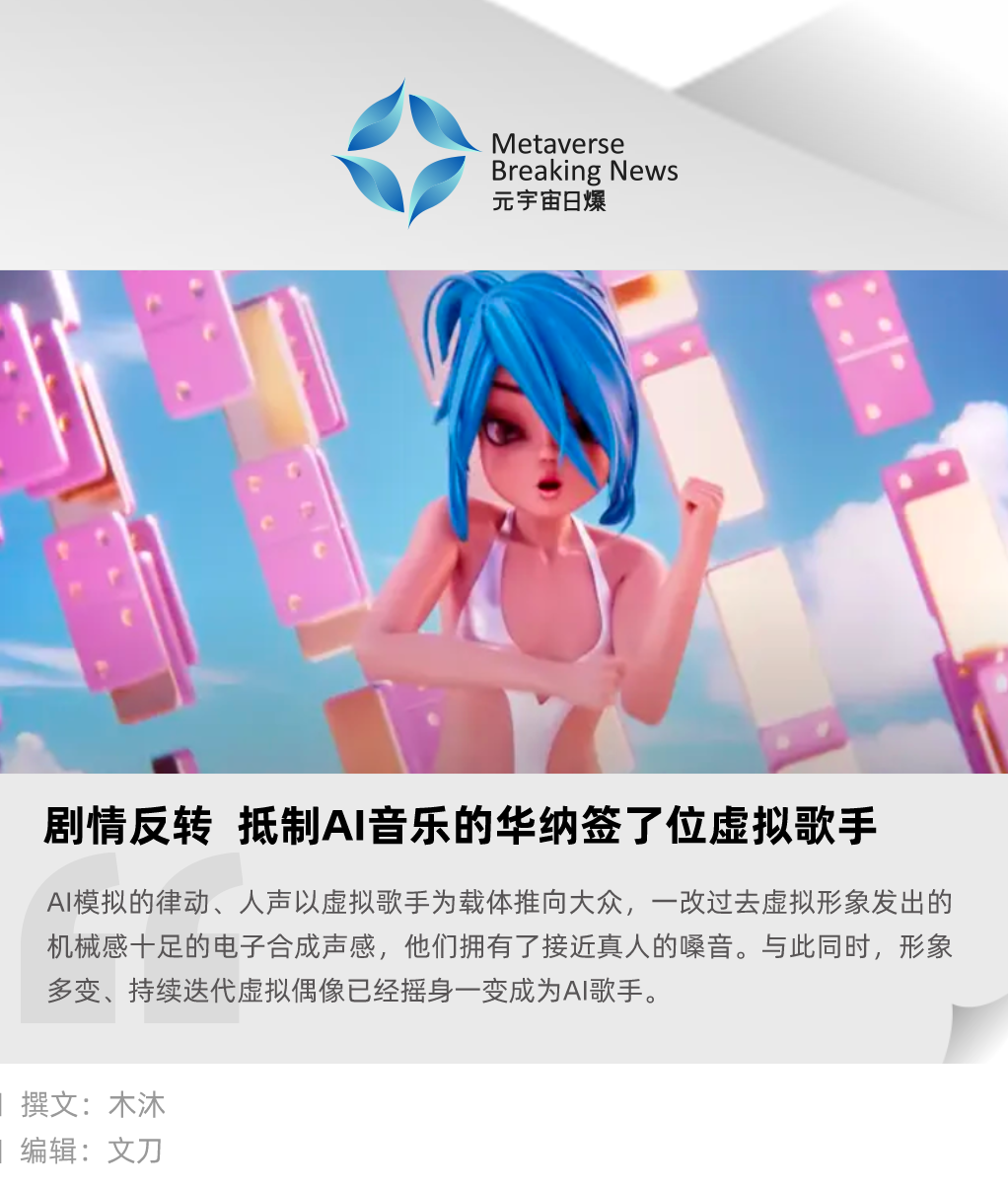
From text, images, and videos to voice and music, AIGC has already permeated into the human visual and auditory experience. Even the giants who once vigorously resisted AI music due to copyright issues have had to change their attitudes and adapt to the products of the times.
In September of this year, Warner Music signed the first virtual singer, Noonoouri; in August, Universal Music and YouTube joined forces to launch the "Music AI Incubator" to address the music copyright issues that arose after the emergence of AIGC.
Compared to overseas, the acceptance of AI music in China seems to be higher. Netease Cloud Music has collaborated with Xiao Bing Company to launch AI music creation tools and has established the first virtual singer label, "WOWAIDO!"
AI-simulated rhythms and vocals, carried by virtual singers, have been pushed to the public, changing the mechanical electronic synthesized sound that virtual images used to emit in the past, and now possessing a voice close to that of a real person. At the same time, the ever-changing and continuously iterating virtual singers have transformed into AI singers, gradually breaking the barrier between virtual and reality, and extending into more application scenarios and commercial value.
Warner Music Signs Virtual Singer Noonoouri

In September of this year, Noonoouri, a virtual internet celebrity with over 400,000 followers on the social media platform Instagram, signed a record contract with Warner Music and released her debut single "Dominoes." Noonoouri thus became the first virtual singer to sign a major record deal.
Noonoouri's virtual image was created in 2018 by the creative artist Joerg Zuber and is positioned as a model character. While traditional animated characters serve to attract fans with stories and plots, Noonoouri was created to endorse high-end fashion brands and has been featured in major mainstream fashion magazines, collaborating with international brands such as Dior, Miu Miu, and Calvin Klein.
After two years of "debut," Noonoouri gained 360,000 fans on Instagram, but in the following two years, her popularity remained stagnant at 400,000 fans. It wasn't until Noonoouri entered Warner Music's artist lineup that she unlocked her identity as a "virtual singer." The music video for the single "Dominoes" has garnered over 250,000 views on Instagram, becoming "her" most influential work in recent years.
"Dominoes" Music Video
Animating a virtual character can be achieved through animation, computer graphics, and even motion capture technology, but where does Noonoouri's voice come from? This is where AI comes into play for this virtual model. It is reported that the singing part of "Dominoes" by Noonoouri is synthesized based on the voice of a real singer using artificial intelligence technology. The creators of the song will receive corresponding royalties and distribution shares.
Warner Music, which signed Noonoouri, had previously resisted AI music due to copyright issues in April of this year, but a few months later, the attitude of this record giant changed.
Another record company, Universal Music, which had previously rejected AI, joined forces with YouTube in August of this year to launch the "Music AI Incubator," aiming to "collaborate with artists and musicians to explore the application of artificial intelligence in music and protect the copyright of music works." In addition, UMG and YouTube's parent company, Google, are also in talks to license artists' voices and melodies to train AI models.
It is not difficult to understand the record companies' shift towards AI technology. Since 2023, AIGC, or generative artificial intelligence, has become a part of daily life, transforming the production of visual, audio, and video content with AI and integrating into the public's visual and auditory experience. Neal Mohan, CEO of YouTube, has stated that in 2023 alone, the number of views of videos related to generative AI tools on YouTube exceeded 1.7 billion.
Faced with the public's acceptance of AIGC, record companies have had to change their thinking and consider how to integrate their accumulated copyright resources with AI. "Training models - creating tools - inspiring creativity" is a good and relatively mature approach. In fact, the combination of music and new tools is not a new phenomenon; early electronic music synthesizers are a case in point.

From Synthesizers to AI Sound Generation Platforms

In the currently popular TV show "The Summer of the Band," the band "Supermarket" has attracted young music fans of this era with their unique electronic music, becoming the first band to introduce electronic music to China.
The acceptance of electronic music by the public is almost entirely due to the use of synthesizers. In the early days of electronic music, synthesizers were hardware devices that produced sound, which was then amplified through an electronic signal meter and expressed through speakers or headphones. With the advent of the computer age, more and more synthesizer software emerged. In terms of modern pop music production, as long as you have a computer, you are fully capable of using synthesizer software to produce a complete music piece.
In 2004, the instrument manufacturer YAMAHA introduced the electronic voice synthesis software VOCALOID, making it easier to create electronic music. Not only music, but even human voices can be synthesized. Creators only need to input the pitch and lyrics, and they can synthesize a voice similar to that of a human. VOCALOID is referred to as "V family" in the domestic 2D circle.
You may not be familiar with the VOCALOID software, but you have definitely heard of virtual idols such as Hatsune Miku, Luo Tianyi, and Stardust, whose voices come from VOCALOID. Do you remember the Finnish traditional folk song "Ievan Polkka" after being covered by Hatsune Miku? This cover song, known as the "Leek Song," went viral.
 The "Leek Song" covered by Hatsune Miku went viral on the internet
The "Leek Song" covered by Hatsune Miku went viral on the internet
When developing VOCALOID, YAMAHA used artificial intelligence, or AI's foundation—big data. They collected a large number of human voice samples and, using neural network synthesis technology, created a sound source library. Users can call up the voices in the library by setting parameters to produce human-like singing effects.
The capabilities of VOCALOID have been used by many virtual idol companies, but the shortcomings of these virtual singers are also very apparent. Because the voices are electronically synthesized, they have a distinct electronic and mechanical sound as soon as they start singing. Therefore, the application of the "V family" is mostly limited to the 2D world.
However, since 2023, under the iteration of AI visual technology, virtual characters have become increasingly realistic, and adding electronic music to their voices would undermine the hard-earned sense of realism. AI can enhance visual effects, and it's no different for auditory effects. Human-like voices trained under large-scale models are now being emitted by virtual characters.
In June of this year, Xiao Bing Company, which previously released "Hanzang Forest Clones," collaborated with Netease Cloud Music to launch the AI music creation software "Netease Cloud Music·X Studio" and established a label called "WOWAIDO!," which includes 12 virtual singers. These virtual singers can sing rock and pop, with vocal tones covering sweet, cute, and melodious styles. In the comments section of these virtual singers, someone said, "I can't believe this is sung by AI."
It is worth noting that the voices of these AI singers are not simply "copied" from a specific natural person; each voice is often synthesized from many different sources. It is reported that the sound sources are vast and have been authorized.
By solving the copyright issue, AIGC has injected "vocal" capabilities into virtual characters. The emergence of AI creation tools such as Netease Cloud Music·X Studio allows musicians to obtain vocal dry tracks in seconds and, through parameter adjustments, present the desired effects of a song to be performed by a singer.
Looking back to when Hatsune Miku was first created, the purpose was also to solve the problem of producers or arrangers not being able to find singers. This kind of "stylistically unconstrained" and "voice container" that breaks traditional human voices, has inspired producers to continuously experiment, giving rise to the profession of virtual idols.
As "Father of Hatsune Miku" Hiroyuki Ito said, "The more digital works are used, the more valuable they become," and what creators are doing is "injecting soul into lifeless things."
免责声明:本文章仅代表作者个人观点,不代表本平台的立场和观点。本文章仅供信息分享,不构成对任何人的任何投资建议。用户与作者之间的任何争议,与本平台无关。如网页中刊载的文章或图片涉及侵权,请提供相关的权利证明和身份证明发送邮件到support@aicoin.com,本平台相关工作人员将会进行核查。




